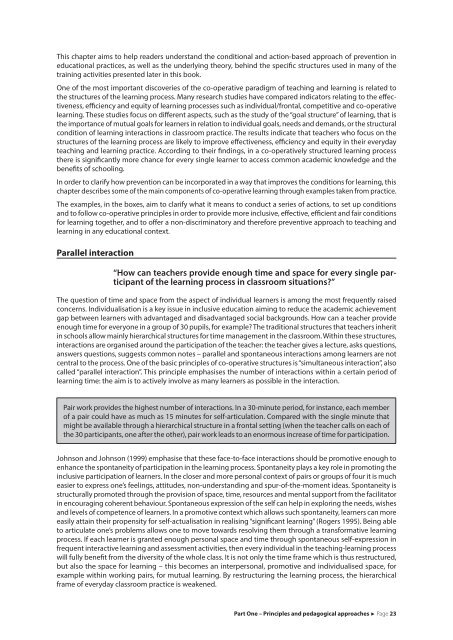TASKs for democracy
4NYw4W
4NYw4W
You also want an ePaper? Increase the reach of your titles
YUMPU automatically turns print PDFs into web optimized ePapers that Google loves.
This chapter aims to help readers understand the conditional and action-based approach of prevention in<br />
educational practices, as well as the underlying theory, behind the specific structures used in many of the<br />
training activities presented later in this book.<br />
One of the most important discoveries of the co-operative paradigm of teaching and learning is related to<br />
the structures of the learning process. Many research studies have compared indicators relating to the effectiveness,<br />
efficiency and equity of learning processes such as individual/frontal, competitive and co-operative<br />
learning. These studies focus on different aspects, such as the study of the “goal structure” of learning, that is<br />
the importance of mutual goals <strong>for</strong> learners in relation to individual goals, needs and demands, or the structural<br />
condition of learning interactions in classroom practice. The results indicate that teachers who focus on the<br />
structures of the learning process are likely to improve effectiveness, efficiency and equity in their everyday<br />
teaching and learning practice. According to their findings, in a co-operatively structured learning process<br />
there is significantly more chance <strong>for</strong> every single learner to access common academic knowledge and the<br />
benefits of schooling.<br />
In order to clarify how prevention can be incorporated in a way that improves the conditions <strong>for</strong> learning, this<br />
chapter describes some of the main components of co-operative learning through examples taken from practice.<br />
The examples, in the boxes, aim to clarify what it means to conduct a series of actions, to set up conditions<br />
and to follow co-operative principles in order to provide more inclusive, effective, efficient and fair conditions<br />
<strong>for</strong> learning together, and to offer a non-discriminatory and there<strong>for</strong>e preventive approach to teaching and<br />
learning in any educational context.<br />
Parallel interaction<br />
“How can teachers provide enough time and space <strong>for</strong> every single participant<br />
of the learning process in classroom situations?”<br />
The question of time and space from the aspect of individual learners is among the most frequently raised<br />
concerns. Individualisation is a key issue in inclusive education aiming to reduce the academic achievement<br />
gap between learners with advantaged and disadvantaged social backgrounds. How can a teacher provide<br />
enough time <strong>for</strong> everyone in a group of 30 pupils, <strong>for</strong> example? The traditional structures that teachers inherit<br />
in schools allow mainly hierarchical structures <strong>for</strong> time management in the classroom. Within these structures,<br />
interactions are organised around the participation of the teacher: the teacher gives a lecture, asks questions,<br />
answers questions, suggests common notes – parallel and spontaneous interactions among learners are not<br />
central to the process. One of the basic principles of co-operative structures is “simultaneous interaction”, also<br />
called “parallel interaction”. This principle emphasises the number of interactions within a certain period of<br />
learning time: the aim is to actively involve as many learners as possible in the interaction.<br />
Pair work provides the highest number of interactions. In a 30-minute period, <strong>for</strong> instance, each member<br />
of a pair could have as much as 15 minutes <strong>for</strong> self-articulation. Compared with the single minute that<br />
might be available through a hierarchical structure in a frontal setting (when the teacher calls on each of<br />
the 30 participants, one after the other), pair work leads to an enormous increase of time <strong>for</strong> participation.<br />
Johnson and Johnson (1999) emphasise that these face-to-face interactions should be promotive enough to<br />
enhance the spontaneity of participation in the learning process. Spontaneity plays a key role in promoting the<br />
inclusive participation of learners. In the closer and more personal context of pairs or groups of four it is much<br />
easier to express one’s feelings, attitudes, non-understanding and spur-of-the-moment ideas. Spontaneity is<br />
structurally promoted through the provision of space, time, resources and mental support from the facilitator<br />
in encouraging coherent behaviour. Spontaneous expression of the self can help in exploring the needs, wishes<br />
and levels of competence of learners. In a promotive context which allows such spontaneity, learners can more<br />
easily attain their propensity <strong>for</strong> self-actualisation in realising “significant learning” (Rogers 1995). Being able<br />
to articulate one’s problems allows one to move towards resolving them through a trans<strong>for</strong>mative learning<br />
process. If each learner is granted enough personal space and time through spontaneous self-expression in<br />
frequent interactive learning and assessment activities, then every individual in the teaching-learning process<br />
will fully benefit from the diversity of the whole class. It is not only the time frame which is thus restructured,<br />
but also the space <strong>for</strong> learning – this becomes an interpersonal, promotive and individualised space, <strong>for</strong><br />
example within working pairs, <strong>for</strong> mutual learning. By restructuring the learning process, the hierarchical<br />
frame of everyday classroom practice is weakened.<br />
Part One – Principles and pedagogical approaches Page 23


